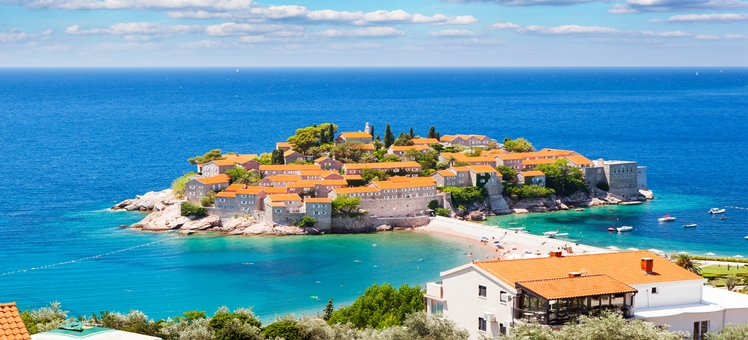
Montenegro may be a small country but it is packed full of striking mountains, dramatic coastlines, remarkable monuments and beautiful walled towns that give you a taste of the Balkans and the Mediterranean. You can enjoy natural attractions in its national parks as well as impressive architecture in its medieval towns and an array of religious buildings.
Ostrog MonasteryMontenegro has many churches and monasteries, but the Serbian Orthodox Monastery of Ostrog deserves particular mention. It's spectacularly located against an almost vertical background in a cliff face 900m above the Zeta valley. Established back in the 17th century, it's now one of the Balkans most popular pilgrimage destinations, attracting up to a million visitors a year. The building houses its own ‘miracle’, called ‘Sv Vasilije’s (St Basil’s) miracle’ due to the precarious position of the upper monastery, protruding out of the rock. No one knows how it came to be there. Pilgrims make the journey to see the shrine inside, where the saint’s bones are kept.
Kotor
The picturesque town of Kotor is a fortified medieval town that has been lovingly maintained. It has an interesting history and as you wander through the labyrinth of narrow and cobblestoned streets, you'll come across lively piazzas and many ancient churches. Make sure you check out the 12th century Romanesque-Gothic St Tryphon Cathedral, the Church of St Luke and the Orthodox St Nicholas Church. On one side of the town is the beautiful blue sea and on the other side is a dramatic steep cliff. If you can manage the walk up 1,500 steps you can see the old fortifications on the top and get some amazing views over the bay.
Stari Bar
On the country's south coast is the town of Bar. ‘Stari Bar’ means ‘Old Town’ and it’s here that you’ll find a wealth of historical treasures. A good starting point is the small museum just inside the entrance that explains the site and its history. In the western part of the town are the remains of St Nicholas' Church, which offers glimpses of Serbo-Byzantine frescoes, while in the northern corner you’ll see a fortress from the 11th century that has good views of the region. Also worth a look are the remaining foundations of St George’s Cathedral. Previously a Romanesque church it was turned into a mosque in the 17th century but then suffered destruction in an explosion that left what you see today. King Nikola’s Palace is in a better condition and is now used as a venue for events as well as a museum.
The National Museum of Montenegro
The National Museum, which is actually a collection of four museums and two galleries housed in a clump of important buildings, is in the old royal capital of Montenegro, Cetinje. The fascinating and well laid out History Museum and the excellent Montenegrin Art Gallery can be found in the former parliament, arguably Cetinje's most impressive building. You have to get a group together for the staff to do the tour, but it's definitely worth the hassle. Plush furnishings, portraits and taxidermied animals capture the spirit of what court would have been like. There is also the castle-like Njegoš Museum and the Ethnographic Museum.
Durmitor National Park
There are four national parks in Montenegro, but the most popular thanks to its rugged landscape is Durmitor. This breath-taking national park, which is the country's largest and is a UNESCO World Heritage Site, was created by glaciers and lots of rivers and underground streams pass through it. Along the Tara River Canyon, which has the deepest gorge in Europe at 1,300 metres, dense pine forests are interspersed with crystal clear lakes, a truly wonderful sight to see. At the heart of Durmitor is the mountain town of Zabljak, a winter ski center with hiking trails around its glacial lakes. There are plenty of activities to enjoy in this park - hiking, biking, mountaineering, swimming, bungee jumping and rafting.